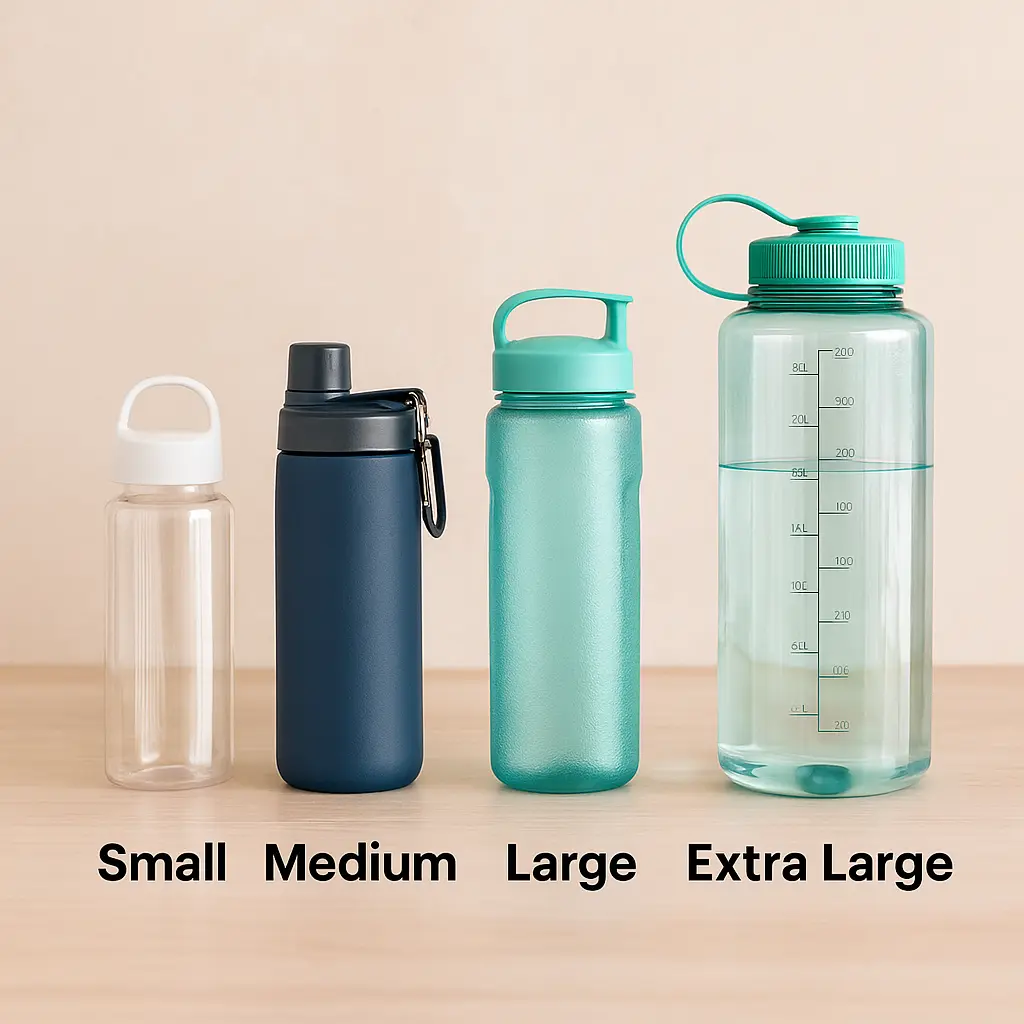Kebanyakan orang dewasa membutuhkan sekitar 2700–3700 ml per hari.
- Distrik Yiwu, Zhejiang, CINA
- [email protected]
- +86 15156387073
Air minum kemasan biasanya berukuran 250 ml hingga 2.000 ml, dengan setiap ukuran memenuhi kebutuhan yang berbeda—mulai dari hidrasi cepat saat bepergian hingga aktivitas luar ruangan seharian. Mengetahui kapasitas yang tepat membantu Anda merencanakan asupan cairan dengan lebih akurat, menyesuaikan ukuran botol dengan gaya hidup Anda, dan menjaga hidrasi yang tepat tanpa minum berlebihan atau kurang.
Daftar isi
Memahami “ml” dalam Botol Air
Saat membahas berapa ml dalam sebotol air, penting untuk memahami arti "ml". Mililiter (ml) adalah satuan untuk mengukur volume cairan, dan 1 ml sama dengan 1/1.000 liter.
Konversi umum:
1.000 ml = 1 liter (L)
500 ml ≈ 16,9 ons cairan (fl oz)
Mengapa hal ini penting:
Membantu Anda melacak asupan air harian Anda secara akurat.
Memudahkan Anda memilih kapasitas yang tepat untuk gaya hidup Anda.
Terutama penting bagi atlet, pendaki, dan siapa pun yang perlu menghitung tingkat hidrasi yang tepat.
Dengan memahami “ml”, Anda dapat dengan cepat menentukan berapa ml dalam sebotol air dan menyesuaikannya dengan kebutuhan harian Anda.
Ukuran Botol Umum dan Kapasitas ml-nya
Saat melihat berapa ml dalam sebotol air, berikut adalah ukuran paling umum yang akan Anda temukan dan bagaimana biasanya digunakan:
| Ukuran Botol | Kapasitas ml | Kasus Penggunaan Umum |
|---|---|---|
| Kecil | 250–330 ml | Untuk anak-anak, perjalanan singkat, atau sebagai cadangan di tas tangan |
| Sedang | 500 ml | Sempurna untuk penggunaan di kantor atau dibawa sehari-hari |
| Besar | 750–1000 ml | Ideal untuk berolahraga atau menghabiskan waktu lama di luar ruangan |
| Ekstra besar | 1500–2000 ml | Cocok untuk hiking, berkemah, atau perjalanan jarak jauh |
Mengetahui kategori ini akan memudahkan Anda memilih ukuran yang tepat saat memutuskan berapa ml air dalam botol yang sesuai dengan kebutuhan Anda.
Cara Memilih Ukuran Botol yang Tepat

Memilih ukuran botol air yang tepat dimulai dengan memahami berapa ml dalam sebotol air dan mencocokkannya dengan tujuan hidrasi harian AndaKebanyakan orang dewasa membutuhkan sekitar 2,7–3,7 liter air setiap hari, yang berarti:
Enam botol 500 ml untuk asupan harian yang seimbang.
Empat botol 750 ml untuk pengisian ulang yang lebih sedikit dan hidrasi yang stabil.
Dua botol 1,5 L saat membawa air untuk seharian penuh di luar ruangan.
Tingkat aktivitas dan lingkungan Anda akan memengaruhi pilihan Anda:
Untuk penggunaan di kantor atau ruang belajar – Botol 500 ml ringan, mudah dimasukkan ke dalam tas atau tempat gelas, dan perlu diisi ulang secara teratur agar air tetap segar.
Sesi olahraga atau pusat kebugaran – Botol berukuran 750 ml hingga 1 L sangat ideal, mengurangi gangguan selama latihan.
Mendaki atau berkemah – Botol 1,5 L hingga 2 L meminimalkan pemberhentian pengisian ulang dan memastikan persediaan yang cukup saat sumber air terbatas.
Perlu diingat bahwa botol yang lebih besar menampung lebih banyak air tetapi juga menambah berat—1,5 L air beratnya sekitar 1,5 kg. Jika portabilitas penting, pertimbangkan untuk menggunakan dua botol berukuran sedang, alih-alih satu botol ekstra besar, demi kenyamanan dan kemudahan yang lebih baik.
Cara Memeriksa Kapasitas ml Botol Anda
Periksa bagian bawah atau label – Sebagian besar produsen mencetak kapasitas di bagian dasar atau sisi botol.
Gunakan gelas ukur – Isi botol dengan air menggunakan gelas yang bertanda dalam mililiter untuk menentukan kapasitasnya.
Timbang botol – Isi botol sepenuhnya dan timbang; karena 1 ml air ≈ 1 gram, beratnya sama dengan kapasitas dalam ml.
Tabel Konversi ml ke Satuan Lain – Berapa ml dalam Sebotol Air
Memahami berapa ml dalam sebotol air bisa lebih mudah jika Anda mengetahui konversi dasar antara mililiter, liter, dan ons cairan AS. Gunakan tabel ini untuk membandingkan kapasitas dengan cepat:
| ml | Liter | ons cairan AS |
|---|---|---|
| 250 ml | 0,25 liter | 8,45 ons |
| 500 ml | 0,5 liter | 16,9 ons |
| 1000 ml | 1 liter | 33,8 ons |
| 2000 ml | 2 liter | 67,6 ons |
Ini membantu Anda melacak hidrasi harian dan memilih ukuran botol yang tepat berdasarkan sistem pengukuran pilihan Anda.
Mengapa Mengetahui ML Membantu Anda Tetap Terhidrasi
Pelacakan hidrasi yang akurat – Mengetahui berapa ml dalam sebotol air memungkinkan Anda mengukur asupan secara tepat, membantu mencegah dehidrasi dan overhidrasi.
Asupan air berbasis sains – Kebutuhan ml harian Anda berubah seiring tingkat aktivitas, iklim, dan pola makan; memahami kapasitas botol memungkinkan Anda menyesuaikan dengan mudah.
Ramah lingkungan & hemat biaya – Memilih ukuran botol yang dapat digunakan kembali yang tepat mengurangi limbah sekali pakai dan menghemat uang untuk pengisian ulang atau pembelian air minum dalam kemasan yang sering.
Pemikiran Akhir tentang Asal Usul Botol Owala
Meskipun banyak orang bertanya di mana botol air Owala dibuat, jawabannya hanyalah sebagian dari cerita. Kualitas produk jauh lebih bergantung pada standar manufaktur, keamanan material, dan manajemen rantai pasokan daripada pada negara asal.
Bagi pembeli dalam jumlah besar, pilihan yang paling aman adalah bekerja sama dengan pemasok yang memiliki pengalaman ekspor terbukti, memegang sertifikasi internasional, dan dapat memberikan rincian produksi yang jelas—memastikan pesanan Anda memenuhi persyaratan peraturan dan harapan pelanggan.
FAQ – Pertanyaan Terkait Tentang Berapa ml dalam Botol Air
1. Apakah 500ml cukup untuk berolahraga?
Cukup untuk latihan pendek, tetapi sesi yang lebih lama membutuhkan lebih banyak air.
2. Berapa ml isi botol standar yang dapat digunakan kembali?
Ukuran umum adalah 500ml, 750ml, dan 1000ml.
3. Dapatkah ml bervariasi untuk ukuran berlabel yang sama?
Ya, karena perbedaan bentuk botol, ketebalan dinding, dan bahan.
4. Berapa ml yang harus saya minum setiap hari?
Kami adalah one stop hadiah khusus perusahaan, yang menawarkan desain, kustomisasi yang dipersonalisasi, pengemasan yang elegan, dan layanan pengiriman untuk membantu Anda meningkatkan kehadiran merek dan memperkuat hubungan pelanggan.
©2025. yourgiftstory Hak Cipta Dilindungi Undang-Undang.

